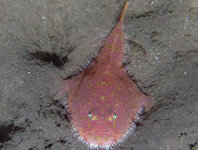Abstract
A new vagrant early-derivative eriophyoid mite species Pentasetacus plicatus n. sp. (GeneBank accession number KT070291) is described from Araucaria araucana (Molina) K.Koch from Chile and Peru with the aid of conventional and confocal laser scanning microscopy. Observations on the gnathosoma of the new species indicate that the oral stylet is bent in the middle and twice shorter than the infracapitular and cheliceral stylets. A trough-like subcapitulum originated from the palpcoxae, and swollen basal parts of chelicerae bearing putative cheliceral seta, were observed under CLSM in specimens with disjointed mouth parts. Males with an exposed gonopore under an uncovered genital coverflap and remnants of soft genital organs were registered. Contrary to other eriophyoids, the plates of the longitudinal bridge in P. plicatus n. sp. and other pentasetacines are not fused so that the genital slit continues posterior to the spermathecal apparatus. The previously established taxon Pentasetacidae Shevchenko, Bagnyuk, Sukhareva, 1991 is proposed for the eriophyoids bearing five prodorsal shield setae (Loboquintus and Pentasetacus); a refined diagnosis of Pentasetacidae is given.
References
Amrine, J.W. Jr., & Manson, D.C.M. (1996) Preparation, mounting and descriptive study of Eriophyoid mites. In: Lindquist, E.E., Sabelis, M.W. & Bruin, J. (Eds), Eriophyoid Mites: Their Biology, Natural Enemies and Control. World Crop Pests 6. Elsevier, Amsterdam, pp. 383–396.
http://dx.doi.org/10.1016/s1572-4379(96)80023-6Amrine, J.W. Jr., Stasny, T.A. & Flechtmann, C.H.W. (2003) Revised Keys to World Genera of Eriophyoidea (Acari: Prostigmata). Indira Publishing House, Michigan, USA, 244 pp.
Chetverikov, P.E. (2014) Comparative confocal microscopy of internal genitalia of phytoptine mites (Eriophyoidea, Phytoptidae): new generic diagnoses reflecting host-plant associations. Experimental and Applied Acarology, 62 (2), 129–160.
http://dx.doi.org/10.1007/s10493-013-9734-2Chetverikov, P.E. (2015) Confocal microscopy reveals uniform male reproductive anatomy in eriophyoid mites (Acariformes, Eriophyoidea) including spermatophore pump and paired vasa deferentia. Experimental and Applied Acarology, 66 (4), 555–574.
http://dx.doi.org/10.1007/s10493-015-9924-1Chetverikov, P.E. & Craemer, C. (2015) Gnathosomal interlocking apparatus and remarks on functional morphology of frontal lobes of eriophyoid mites (Acariformes, Eriophyoidea). Experimental and Applied Acarology, 66 (2), 187–202.
http://dx.doi.org/10.1007/s10493-015-9906-3Chetverikov, P.E. & Desnitskiy, A.G. (2016) A study of embryonic development in eriophyoid mites (Acariformes, Eriophyoidea) with the use of thefluorochrome DAPI and confocal microscopy. Experimental and Applied Acarology, 68, 97–111.
http://dx.doi.org/10.1007/s10493-015-9982-4Chetverikov, P.E., Cvrković, T., Vidović, B. & Petanović, R.U. (2013) Description of a new relict eriophyoid mite, Loboquintus subsquamatus n. gen. & n. sp. (Eriophyoidea, Phytoptidae, Pentasetacini) based on confocal microscopy, SEM, COI barcoding and novel CLSM anatomy of internal genitalia. Experimental and Applied Acarology, 61 (1), 1–30.
http://dx.doi.org/10.1007/s10493-013-9685-7Chetverikov, P.E., Beaulieu, F., Beliavskaia, A.Y., Rautian, M.S. & Sukhareva, S.I. (2014) Redescription of an early-derivative mite, Pentasetacus araucariae (Eriophyoidea, Phytoptidae), and new hypotheses on the eriophyoid reproductive anatomy. Experimental and Applied Acarology, 63, 123–125.
http://dx.doi.org/10.1007/s10493-014-9774-2Chetverikov, P.E., Cvrković, T., Makunin, A., Sukhareva, S., Vidović, B.& Petanović, R. (2015) Basal divergence of Eriophyoidea (Acariformes, Eupodina) inferred from combined partial COI and 28S gene sequences and CLSM genital anatomy. Experimental and Applied Acarology, 67 (2), 219–245.
http://dx.doi.org/10.1007/s10493-015-9945-9Craemer, C. (2010) A systematic appraisal of the Eriophyoidea (Acari: Prostigmata). PhD Dissertation, Faculty of Natural and Agricultural Sciences, University of Pretoria, Pretoria, South Africa, November 2010.
Nuzzaci, G., & de Lillo, E. (1991) Linee evolutive dello gnatosoma in alcuni Acari Prostigmata. Atti XVI Congresso Nazionale Italiana Di Entomologia, Bari, 279–290.
Lindquist, E.E. (1996a) 1.5.2 Phylogenetic relationships. In: Lindquist, E.E., Sabelis, M.W. & Bruin, .J (Eds), Eriophyoid Mites: Their Biology, Natural Enemies and Control. World Crop Pests 6. Elsevier Science, Amsterdam, pp. 301–327.
Lindquist, E.E. (1996b) External anatomy and notation of structures. In: Lindquist, E.E., Sabelis, M.W. & Bruin, J. (Eds), Eriophyoid Mites: Their Biology, Natural Enemies and Control. World Crop Pests 6. Elsevier, Amsterdam, pp. 3–31.
http://dx.doi.org/10.1016/S1572-4379(96)80003-0Monfreda, R., Nuzzaci, G. & de Lillo, E. (2007) Detection, extraction, and collection of eriophyoid mites. Zootaxa, 1662, 35–43.
Nuzzaci, G. (1979) Contributo alla conoscenza dello gnatosoma degli Eriofidi (Acarina: Eriophyoidea). Entomologica, 15, 73–101.
Nuzzaci, G. & Alberti, G. (1996) Internal anatomy and physiology. In: Lindquist, E.E., Sabelis, M.W. & Bruin, J. (Eds), Eriophyoid Mites: Their Biology, Natural Enemies and Control. World Crop Pests 6. Elsevier, Amsterdam, pp. 101–150.
http://dx.doi.org/10.1016/S1572-4379(96)80006-6Schliesske, J. (1985) Zur Verbrietung und Ökologie einer neunen ursprünglichen Gallmilbenart (Acari: Eriophyoidea) an Araucaria araucana (Molina) K. Koch. Entomologische Mitteilungen aus dem Zoologischen Museum Hamburg, 8, 97–106.
Shevchenko, V.G., Bagnyuk, I.G. & Sukhareva, S.I. (1991) Novoye semeistvo chetirekhnogikh klesvchei Pentasetacidae (Acariformes, Tetrapodili) i ego znachenie dlya traktovki proizhozdeniya evolyutsii gruppy [A new family of four-legged mites, Pentasetacidae (Acariformes, Tetrapodili) and its importance to interpretation of the group’s origin and evolution]. Zoologicheskii zhurnal, 70, 47–53. [in Russian]

